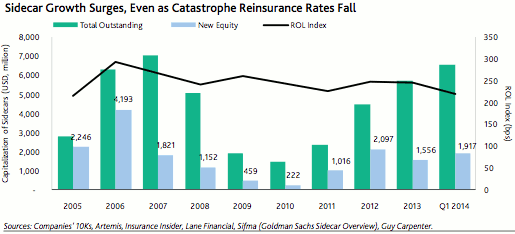The collateralized reinsurance sidecar, as a vehicle for risk transfer backed by investor capital, is expected to proliferate as more reinsurers choose to sponsor sidecars and grow as more capital flows into these entities as the market continues to evolve.
A reinsurance sidecar is a financial structure established to allow a sponsor to share or cede risk to investors, or third-party capital, allowing them to take on the risk and benefit from the return of specific books of insurance or reinsurance business.
Reinsurance sidecar vehicles allow the sponsor to cede risk efficiently, controlling what they cede and the terms of any quota-share, while investors can access a reinsurers returns directly through participating in a portion of their book of business. This allows the risks and rewards of the business ceded to the sidecar to be shared between re/insurers and investors.
During the first quarter of 2014, new capital invested in reinsurance sidecars reached $1.92 billion, according to research by rating agency Moody’s Investors Service. This is the highest level of new capital flow into reinsurance sidecars in a single quarter since 2009, according to Moody’s, which shows the level of investor appetite for accessing the returns of reinsurance business at the moment. This was also more capital than was invested in reinsurance sidecars in the whole of 2013.

Reinsurance sidecar growth trends
The motivations for sponsoring a sidecar have likely changed, said Moody’s, as evidenced by the fact that inflows of new capital are up despite reinsurance pricing having declined. The last time there was a sharp increase in new capital flowing into reinsurance sidecars it was after hurricane Katrina in 2005-2006.
At that time the increased demand for coverage pushed premiums up and sidecars were used as a way for reinsurers to move risk off balance-sheet, so allowing them to offer more capacity, while sharing the premium profits with investors keen to access the higher reinsurance returns.
Conversely, this year reinsurance rates are down but investor interest is high as the capital markets increasingly invests in reinsurance linked assets. This has led to reinsurers using sidecars more as a means to maintain, or grow, market share using lower-cost capital rather than to free up capacity.
This interesting distinction between the two periods of high sidecar growth is perhaps the difference between a reactive market, reacting to a heavy loss and a proactive market finding ways to capitalise on new lower-cost capital and investors appetite for risk.
As there are benefits on both sides of a sidecar formation, for the sponsoring insurer or reinsurer and for the investors in the vehicle, Moody’s expects the influx of new capital into sidecars will continue. It allows investors to benefit from the underwriting expertise at reinsurers and to share in premiums and profits, while giving reinsurers a source of efficient capacity enabling them to underwrite at a reduced cost-of-capital and earn fees as well as a share in the sidecars profits.
Moody’s notes that sidecars are evolving and their features are likely to evolve further as this demand continues, which would again point towards more growth as the vehicles become more flexible and allow greater levels of specialisation.
Moody’s believes that more reinsurers will sponsor sidecars and that the amount of capital within existing and new collateralized sidecar vehicles is set to grow. Moody’s also believes that their focus will broaden as the market evolves. In fact sidecars are ideal vehicles to enable investors to access new classes of business and types of risk and could become areal source of innovation for the insurance linked investment market.
Because of this, Moody’s expects the sidecar to increasingly influence the evolving insurance and reinsurance markets and their evolving competitive dynamics. One feature becoming increasingly common is the multi-year reinsurance sidecar, something which effectively turns a sidecar into a fund with a limited lifespan, from an investor perspectives.
Hybrid vehicles will likely become increasingly common, serving a sidecar type function and allowing investors to access an insurer or reinsurers risk. Start-ups in the reinsurance space are also increasingly resembling sidecars, such as Blue Capital Re and even Watford Re, with this trend expected to continue as the use of sidecars grows.
View our list of reinsurance sidecar vehicles.
Note: Moody’s study of sidecars includes some reinsurer start-ups and vehicles which are not strictly sidecars in the traditional sense, but are providing a service much like a sidecar in allowing a reinsurer to cede a portion of its risk in a controlled and segregated manner to investors. Hence the numbers quoted by Moody’s are quite large due to the inclusion of reinsurer start-ups, with an example of this being Watford Re.
 View all of our Artemis Live video interviews and subscribe to our podcast.
View all of our Artemis Live video interviews and subscribe to our podcast.
All of our Artemis Live insurance-linked securities (ILS), catastrophe bonds and reinsurance video content and video interviews can be accessed online.
Our Artemis Live podcast can be subscribed to using the typical podcast services providers, including Apple, Google, Spotify and more.































